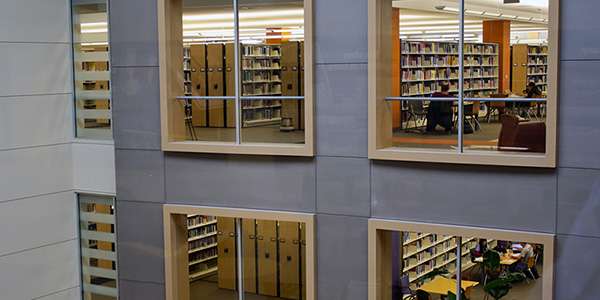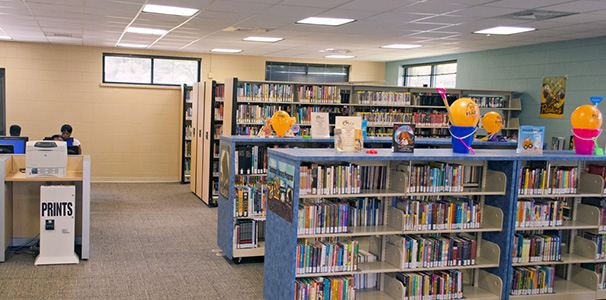College campuses don’t look like they did when I was an undergrad. Changes in education delivery, technology, and learning methods and styles have led to re-imagining how university and school buildings function. As Linda Skelton pointed out after a visit to her alma mater: “The university has done a wonderful job of maintaining the integrity of the original buildings, but inside they renovated them all to meet the changing needs of today’s students.”
And in no building is this more apparent than in the library. There is a big push to re-purpose libraries – both campus and public, and a growing need to create space used for things other than book storage. Spaces to study, gather, learn, meet, converse, grab a cup of coffee – these are what today’s libraries do, or are expected to, provide.
There are several ways to approach this challenge, let’s take a look at a few of them.
- Construct a new building or add on an existing facility. There are situations where this is the best solution, but this approach has drawbacks. New construction can be cost-prohibitive. There are limits to the amount of land available to build on, and some campuses are land locked. There are potential sustainability and conservation hurdles to overcome.
- Store more material in less space. By compacting book, journal and media storage onto high-density mobile shelving, libraries can free up space for other uses. There can be safety concerns and a learning curve for the public or students using these types of systems.
- Store some (or all) material off-site. By moving physical material out of the library, the previous storage space can now be repurposed. With the material stored off-site, there is a trade off with the speed of which a volume can be accessed.
Now let’s take a field trip to a few places so we can learn by example:
Example 1: Alvin Sherman Library and Information Technology Center
A traditional public library and full-service academic library together in one building! That’s what happened when Broward County (FL) Library System and Nova Southeastern University teamed up to build the Alvin Sherman Library and Information Technology Center. At five-stories (325,000 sq. ft.), it is one of the largest libraries in Florida and includes study rooms, classrooms, computer labs, auditorium, exhibition gallery and a cafe. But as large as this building is, the footprint would’ve been huge if not for the use of high-density mobile shelving – which exists on several floors for both public and academic library storage. These systems nearly doubled their book storage capacity!
Example 2: College of Charleston – Addlestone Library
The College of Charleston had a plan when they opened the 145,000 sq. ft. Addlestone Library. To maximize their collection storage without increasing the size of their building, they would use high-density mobile shelving, and do so in a phased approach. In 2010, when we first highlighted this project, they stored about a third of their collections on mobile shelving. At the time we noted: “They were able to plan for future growth at the time of the design and construction of the new building – columns and floor slabs throughout the stack areas of the building were reinforced. (The structural requirement for the floor load of high-density shelving is 300 pounds per square foot, versus 150 for standard shelving). So, when the time comes, they can replace static shelving with additional high-density systems.” The time to replace the static shelving with high-density has since passed! The entire book collection now lives in mobile shelving on the 2nd floor. And the best part of this story is what else they can do in all of that freed up space. I could tell you about it, but it would be much more fun to see for yourself in this excellent video College of Charleston created:
Example 3: Bucksport Public Library
The Bucksport Library is a branch library located in Conway, South Carolina. It is part of the Horry County Memorial Library System. A recent library bond referendum provided funds to make upgrades to the library, but not enough money for construction of a new building.
Initial library renovation plans included a powered high-density mobile shelving system in the back third of the library to hold most of the circulating collection minus juvenile materials. The high-density system would store all of the existing collections and reclaim 2/3rds of the library for other uses.
Because there would be public access to the mobile shelving system, the safety of the patrons was a primary consideration in evaluating the solution. So several safety features such as Zero Force Sensors (ZFS), a completely “passive” safety system, Aisle Entry Sensors, and Vertical Safety Sweeps were included. These safety features helped alleviate the staff’s concerns and made the mobile shelving solution a viable option for the project.
In conjunction with a complete redesign of the library’s layout, the high-density mobile shelving system helped recover plenty of usable space. The space saved was used to add five more computers and for flex space for large programs, and a small meeting room was converted to both a meeting and a reference/periodical reading room.
Example 4: University of Virginia – Ivy Stacks
The renovated Ivy Stacks facility just celebrated the 3-year completion anniversary of their renovation. UVa made two crucial choices when deciding how to double their storage capacity at Ivy Stacks: (a) they implemented the Harvard model for library material storage, which organizes materials by height rather than category. And (b) they installed an XTend High-density Mobile High Bay Shelving system, which doubled the capacity of the existing static high bay shelving. These choices turned out to be worth a cool $7 million. (A new building to house their growing collection was expected to cost $12 million while the renovation of the existing facility – including the new storage systems – cost around $5 million). And if you are wondering how the material request and delivery process works, check out this video from UVA Magazine:
These are just a few of the many examples of the changes happening in public libraries and on college campuses all around the country. The challenge of re-purposing libraries has been accepted. The good news is that unlike a calculus equation, there are several ways to solve this challenge. As Fall approaches, my mind drifts back to college. Wouldn’t it be great to relive those 4 (or 5 or 6) years? Not so much the studying and the stress, but to enjoy all these campus facility upgrades and grab a cup of joe at the Starbucks in the campus library. Just don’t forget the change.












